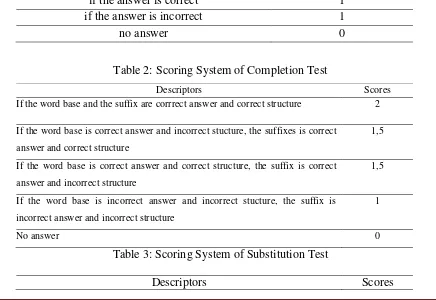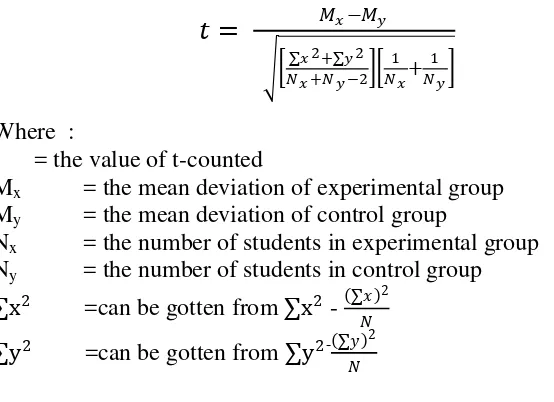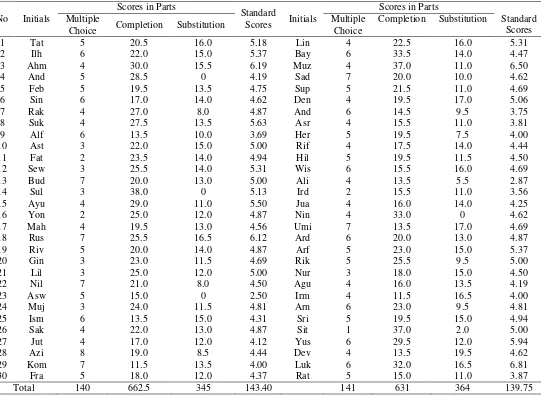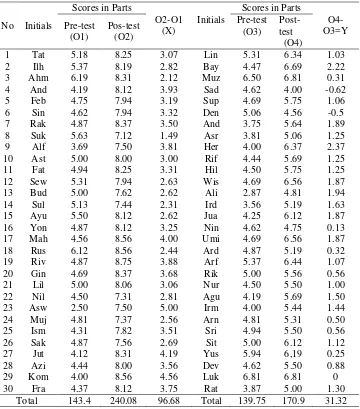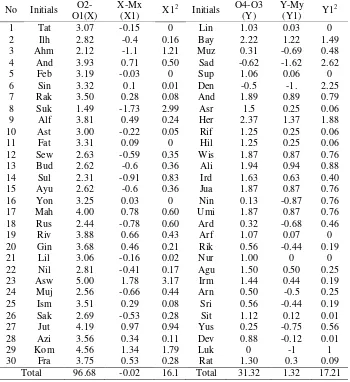e-Journal of English Language Teaching Society (ELTS) Vol. 3 No. 1 2015 – ISSN 2331-1841 Page 1
THE USE OF SUBSTITUTION DRILL
IN TEACHING DERIVATIONAL SUFFIXES
IN FORMING NEW WORD CLASSES
Novrin Kartika Tumbade1, Jamiluddin2, Nadrun3
Abstract
This research aimed at proving that the use of substitution drill in teaching derivational suffixes can increase the students’ ability of the eleventh year students of SMA Negeri 1 Witaponda in forming new word classes. This research applied experimental research design. The sample of this research was the eleventh year students of SMA Negeri 1 Witaponda. The sample was taken through simple random sampling technique. The data were collected by using two kinds of instruments: observation and test. The data from the observation were analysed descriptively, while the data from the test were analysed statistically. The results of the test showed that the t-counted (11.1) was higher than t-table (2.002). It means that the hypothesis is accepted. In short, the use of substitution drill in teaching derivational suffixes can increase the ability of the eleventh year science major students of SMA Negeri 1 Witaponda.
Keywords: substitution drill; derivational suffixes: word classes
INTRODUCTION
Language has important role in our lives. It plays an essential role in the advance in
the field of education. English is one of the subjects taught from elementary schools up to
universities. In learning English, we should master the language components. Vocabulary is
needed to support the four language skills: speaking, writing, reading, listening. Mastering
those skills will determine the use of English language. Allen (1983:149) argues: “Vocabulary is very important in a language, when we learn the words of the language”.
Based on the statement above, word is one of the language components needed to be
mastered by the students. The students with low English words mastery might find a serious
difficulty to master English. The word is an essential language component to learn in order to
achieve the language skills successfully. Someone who has mastered English words gets easy
to study English either in speaking or in writing and to communicate with others. The words
1
Prodi Pendidikan Bahasa Inggris FKIP Universitas Tadulako - email: [email protected] 2
email: [email protected] 3
e-Journal of English Language Teaching Society (ELTS) Vol. 3 No. 1 2015 – ISSN 2331-1841 Page 2 are fundamental. The more words they have, the easier they state their minds, ideas, opinion,
or intention through the language skills performance.
Napa (1991:6) argues, “Vocabulary is one of the components of language and that no one language exists without words, words are signs or symbols for ideas”. It means that the meaning of every word is based on what people thought.
This research was about how the substitution drill in teaching derivational suffixes
increase the students’ ability in forming new word classes. When we talk about class of
words, we talk about the base and affixes. Those are very common in morphology to arrange
the larger unit of language. In English, affixes can be divided into two kinds according to
their position, namely prefixes and suffixes. Suffixes are bound morphemes that added at the
end of the root of words. Suffixes that are attached to root show whether the words are verbs,
adjectives, nouns, or adverbs. Knowing the progression of derivational suffixes, we can make
or produce a variety of new words from the root or base of words without looking up in the
dictionary. Besides that, by mastering the way of adding suffixes to the root or base, we can
produce variety of word classes such as verbs, noun, adjective, and adverb.
Based on the explanation above, the researcher realizes that recognizing word classes
that has additional suffixes is very useful for English learners to produce variety of words and
to know how to put them in the sentence based on the function of the word that play in the
sentence.
Based on the statement above, the researcher formulated a research question as follows:
Can the use of substitution drill in teaching derivational suffixes in forming new word classes? it was to find out the use of substitution drill in teaching derivational suffixes can
increase the students’ ability of the eleventh year students of SMA Negeri 1 Witaponda in
forming new word classes.
METHODOLOGY
In conducting this research, the researcher used true experimental research design.
The sample of the research was divided into two groups, experimental group and control
group. Both groups were given pre-test and post-test. However, the experimental group was
taught using substitution drill while the control group was taught conventionally.
This research was conducted based on the following research design proposed by Best
(1981:70) as follows:
e-Journal of English Language Teaching Society (ELTS) Vol. 3 No. 1 2015 – ISSN 2331-1841 Page 3
R2 O3 O4
Where:
R1 = experimental group
R2 = contol group
O1O3 = pre-test
X = treatment
O2O4 = post-test
The population of this research was the eleventh years students of SMA 1 Witaponda.
It consisted of three parallel classes and the total number of the population was 60 students.
The sample of this research was chosen through simple random sampling. In this research,
there are two variables, dependent and independent. Teaching derivational suffixes of the eleventh year science major student of SMA negeri 1 Witaponda in forming new word classes
is dependent variable that will be given an effect by independent variable, while the use of substitution drill is independent variable that will give an effect to dependent variable.
In conducting this research, the researcher gave test. Test is consisted of three parts.
They were objective test, completion test, and substitution test. Before conducting treatment,
the researcher gave the pre-test. The explanation about scoring system is provided in the
following table.
Table 1: Scoring System of Objective Test
Descriptors Scores
if the answer is correct 1
if the answer is incorrect 1
no answer 0
Table 2: Scoring System of Completion Test
Descriptors Scores
If the word base and the suffix are corrrect answer and correct structure 2
If the word base is correct answer and incorrect stucture, the suffixes is correct
answer and correct structure
1,5
If the word base is correct answer and correct structure, the suffix is correct
answer and incorrect structure
1,5
If the word base is incorrect answer and incorrect stucture, the suffix is
incorrect answer and incorrect structure
1
No answer 0
Table 3: Scoring System of Substitution Test
e-Journal of English Language Teaching Society (ELTS) Vol. 3 No. 1 2015 – ISSN 2331-1841 Page 4 If the word class is correct answer, the word is correct answer and
correct structure
2
If the word class is correct answer, the word in correct answer and incorrect structure
1,5
If the word class is incorrect answer, the word is incorrect answer and correct structure
1
If the word class is incorrect answer, the word is incorrect answer and incorrect structure
1
No answer 0
After giving pre-test, the researcher applied treatment. The treatment was conducted for
six times excluding pre-test and post-test. In order to know the progress of the students’
ability after the treatment, the researcher gave post-test at the last meeting. The post-test was
the same as the pre-test. The aim of doing is used to measure students’ ability in forming new
word classes and to know whether the treatment was effective or not.
The result of test was analyzed statistically. The researcher firstly computed the
individual score by using formula proposed by Tuckman (1978:132):
∑ = �
The researcher calculated the mean score of students in each test. Then the researcher
computed the mean deviation between pre-test and post-test. She employed the formula
In order to know whether the students’ pre-test and post-test have significant difference,
e-Journal of English Language Teaching Society (ELTS) Vol. 3 No. 1 2015 – ISSN 2331-1841 Page 5
�
=
−∑ 2++ ∑−22 1 + 1
Where :
t = the value of t-counted
Mx = the mean deviation of experimental group My = the mean deviation of control group
Nx = the number of students in experimental group Ny = the number of students in control group ∑x2 =can be gotten from∑x2 - ∑ 2
∑y2 =can be gotten from ∑y2- ∑ 2
FINDINGS
The researcher examined the students before and after the treatment. In order to know
the students’ ability in forming word classes before the treatment, she gave the pre-test. The
researcher gave the post-test to the students at the end of the treatment on the purpose of knowing whether the teaching can increase the students’ ability or not. The result of the pre-test of the experimental and control groups can be seen in the table 4.
Based on the table 4 below, the sum of the students’ score in the pre-test of the experimental group was 143.4 while 139.75 for the control group. To determine the mean
score of those score, the researcher gained the mean score of the pre-test of the experimantal
group:
Mx = ∑
Mx = 143.4
30
Mx = 4.77
Therefore, the mean score of the pre-test of the experimental group was 4.77. After
getting the mean score of the pre-test of the experimental group, the researcher calculated the
mean score of the pre-test of the control group:
My = ∑
My = 139.75
30
My = 4.66
Therefore, the mean score of the pre-test of the control group was 4.66. The result of
the pre-test of both groups can be seen in the following table.
e-Journal of English Language Teaching Society (ELTS) Vol. 3 No. 1 2015 – ISSN 2331-1841 Page 6
From both calculations, the researcher find the mean score of the experimental group
is 4.77 and the mean score of the control group is 4.66. There was no significant difference
between the mean scores of both groups. In other words, there is no difference in level of
knowledge between the experimental group and control group before the treatment.
After giving the treatment, the researcher gave the post-test to the experimental group
and control group. The post-test had the same items as the pre-test. The aim of giving the
post-test was to measure the final score that showed the progress made by the students. After
calculating the mean score of the pre-test of experimental and control groups, the researcher
calculated the mean score of the post-test of control group. The data of the post-test of
experimental and control groups can be seen in the table 5 below:
e-Journal of English Language Teaching Society (ELTS) Vol. 3 No. 1 2015 – ISSN 2331-1841 Page 7
After getting the mean score of both groups, the researcher calculated the mean score of
the post-test of both groups. To determine the mean score of those score, the researcher
gained the mean score of the post-test of both groups:
Mx = ∑ My = ∑
Therefore, the mean score of the post-test of the experimental group was 8 while 5.7 for
the control group. It had significant progress of mean score from 4.77 in the pre-test to 8 in
e-Journal of English Language Teaching Society (ELTS) Vol. 3 No. 1 2015 – ISSN 2331-1841 Page 8 the pre-test and post-test of both group. The data of the pre-test and post-test can be seen in
the following table:
Table 6: Pre-test and Post-test of Experimental and Control Group
No Initials
deviation of both groups. The researcher applied Arikunto’s formula. In this computation,
the researcher computed the mean deviation to determine the mean score of the experimental
group as follows:
Mx = ∑
e-Journal of English Language Teaching Society (ELTS) Vol. 3 No. 1 2015 – ISSN 2331-1841 Page 9 After computing the mean deviation of the experimental group, the researcher
continued to calculate the mean deviation of contol grousp. The researcher computed the
mean deviation to determine the mean score of control group as follows:
My
=
∑My
=
31.3230
My = 1
After computing the mean deviation of both groups, the researcher continued to
calculate the sum-squared deviation around the mean of the experimental and control groups.
The data of the deviation of both groupscan be seen in the following table:
Table 7: The Deviation in the Pre-test and Post-test of the Experimental and Control Group
No Initials
O2-calculated the sum-squared deviation around the mean of the control and experimental groups
e-Journal of English Language Teaching Society (ELTS) Vol. 3 No. 1 2015 – ISSN 2331-1841 Page 10
As the result, the sum-squared deviation of the experimental group was 15.76 and the
sum-squared deviation of the control group was 7.18.After having the sum-squared deviation
around the mean of experimental and control group, the researcher continue to find out the
significant difference of the two groups by using t-test formula by Arikunto as follows:
t
= −From above computation, the researcher found that the significant difference between
the result of the pre-test and the post-test of the students was 11.1.
DISCUSSION
Based on the result of observation, the researcher found that the students rarely used
English during the teaching process due to the lack of vocabulary. It was known from the students’ way of speaking in which they mostly used Bahasa Indonesia. In relation to the
students’ condition before treatment, both groups had equal capability in connection with the
word classes mastery that has additional derivational suffixes.
With respect to the result of data analysis of the mean scores of the pre-test of both
e-Journal of English Language Teaching Society (ELTS) Vol. 3 No. 1 2015 – ISSN 2331-1841 Page 11 The students of both groups had many errors in answering the test. They have difficulties in
identifying word classes of word bases, the class of the word which have additional
derivational suffixes and what suffixes that can form adjectives or nouns. The students also
made writing error in subtituting the word classes from word bases that attach with the
suffixes. The researcher found students’ error of the experimental group in the pre-test was
57.96 % while 58.33 % for the control group.
After getting the problem that faced by the students of SMA Negeri 1 Witaponda
above, she conducted her treatment for six meeting. There are six derivational suffixes taught
in the treatment. They were derivational suffixes to form nouns and derivational suffixes to
form adjectives. Derivational suffixes to form nouns were -ness, -ment and -ion. Derivational
suffixes to form adjectives were –able, -ful, and –ive. In conducting the treatment, the
researcher found that there were levels of difficulty of each derivational suffix that already
taught to the students. In the other words, the researcher categorized what derivational suffix
was more difficult than the other suffixes.
Based on the explanation above, the researcher started to explain what derivational
suffix in forming noun and adjective was more difficult than the other suffixes and what
derivational suffix was easier than the other suffixes. The researcher categorized the error
ranking of the students in each derivational suffix to form nouns and adjectives. The error
ranking of the students determined what derivational suffixes were more difficult than other
suffixes. The researcher analyzed the students’ error in derivational suffixes to form nouns
and adjectives. The students’ error of the experimental group were 37.01% in derivational
suffixes to form nouns and 50.45% in derivational suffixes to form adjectives while the
students’ errors of the control group got 47.67% in derivational suffixes to form nouns and
60.5% in derivational suffixes to form adjectives. It showed that derivational suffixes to form
adjectives were more difficult than derivational suffixes to form noun.
Before getting the students’ error in derivational suffixes to form noun and adjective
above, the researcher started to analyze the students’ error in the pre-test of both groups. The
researcher calculated the students’ error in the derivational suffixes to form nouns and
adjectives. The researcher found that the students’ error of the experimental group were 60.6% in suffix –ness, 45.8% in suffix –ment, 39.7% in suffix –ion, 73.9% in suffix –ful,
e-Journal of English Language Teaching Society (ELTS) Vol. 3 No. 1 2015 – ISSN 2331-1841 Page 12 After giving the treatment, the researcher gave the post-test to the students. Having
given a treatment there was a significant difference between experimental group and control
group results. The students in the experimental group who passed the passing grade were
83.3% while 0% or no students in the control group. Then, the result of data analysis showed
that the mean score of the post-test of the experimental group was 8 while a control one was
5.7. The students’ error of the post-test of the experimental group was 28.5% while 49.83%
for the control group. The researcher started to compute the students’ error of the
experimental group in derivational suffixes to form nouns and adjectives. Firstly, the
reseacher found that the students’ error of the post-test of the experimental group that has
applied the substitution drill were 30% in suffix –ness, 25% in suffix –ment, 21% in suffix
-ion, 31% in suffix –ful, 20% in suffix –able, and 50% in suffix –ive. After getting the students’ error of the post-test of the experimantal group, the researcher calculated the students’ error in control group were 58% in suffix –ness, 55% in suffix –ment, 25% in suffix –ion, 63% in suffix –ful, 31% in suffix –able, and 67% in suffix –ive.
By observing the result of the test before and after treatment, the researcher found that the use of substitution drill in teaching derivational suffixes can increase the students’ ability in forming word classes. The students of the experimental group could understand easily how
to form new word classes in word bases that has additional derivational suffixes. Beside that,
the vocabulary of the students improved after they got the treatment during sixth meetings.
They also could identified easily the word classes of the words without opening the
dictionary. It can be seen from the score of post-test after they got treatment. Therefore, the
researcher assumed that the use of substitution drill in teaching derivational suffixes lead the
students to recognize the word classes without opening the dictionary entirely.
CONCLUSION AND SUGGESTIONS
After discussing and analyzing the finding of the research, the researcher concludes that
the use of substitution drill in teaching derivational suffixes can increase the students’ ability
in forming word classes. It was proved by testing hypothesis in which t-counted (11.1) is
higher then t-table value (2.002). It showed that the researcher used substitution drill as a
suitable technique in teaching derivational suffixes to form new word classes. The substitution drill could increase effectively the students’ ability in forming word classes. The researcher can make the students understand and be interested in learning word classes that
have additional derivational suffixes by applying substitution drill. The students also have
e-Journal of English Language Teaching Society (ELTS) Vol. 3 No. 1 2015 – ISSN 2331-1841 Page 13 recognize word classes without opening dictionary. In other words, they could increase their
vocabulary.
These are the following suggestions that the researcher would like to share in order to
get the better result in teaching learning process. Firstly, the English teacher could apply the
substitution drill as a good technique in teaching derivational suffixes in forming new word
classes and motivate their students in teaching English words. Secondly, the students should
have a great motivation in learning English words and develop their understanding of
derivational suffixes to form new word classes because motivation is one of many factors to
learn English successfully. Thirdly, for the other researchers who are interested in choosing
this topic as the topic of the research, it can be good references in the future research.
REFERENCES
Allen, V. F. (1983). Technique in Teaching Vocabulary. Oxford: Oxford University Press. Arikunto, S. (2002). Prosedur Penelitian Suatu Pendekatan Praktek. (Edisi Revisi V).
Jakarta: Rineka Cipta.
Arikunto, S. (2006). Prosedur Penelitian Suatu Pendekatan Praktek. (Edisi Revisi V). Jakarta: Rineka Cipta.
Best, J. W. (1981). Research in Education. New Jersey: Prentice – Hall, Inc.
Napa, P. A. (1991). Vocabulary Development Skill. Jakarta: Kanisius.
